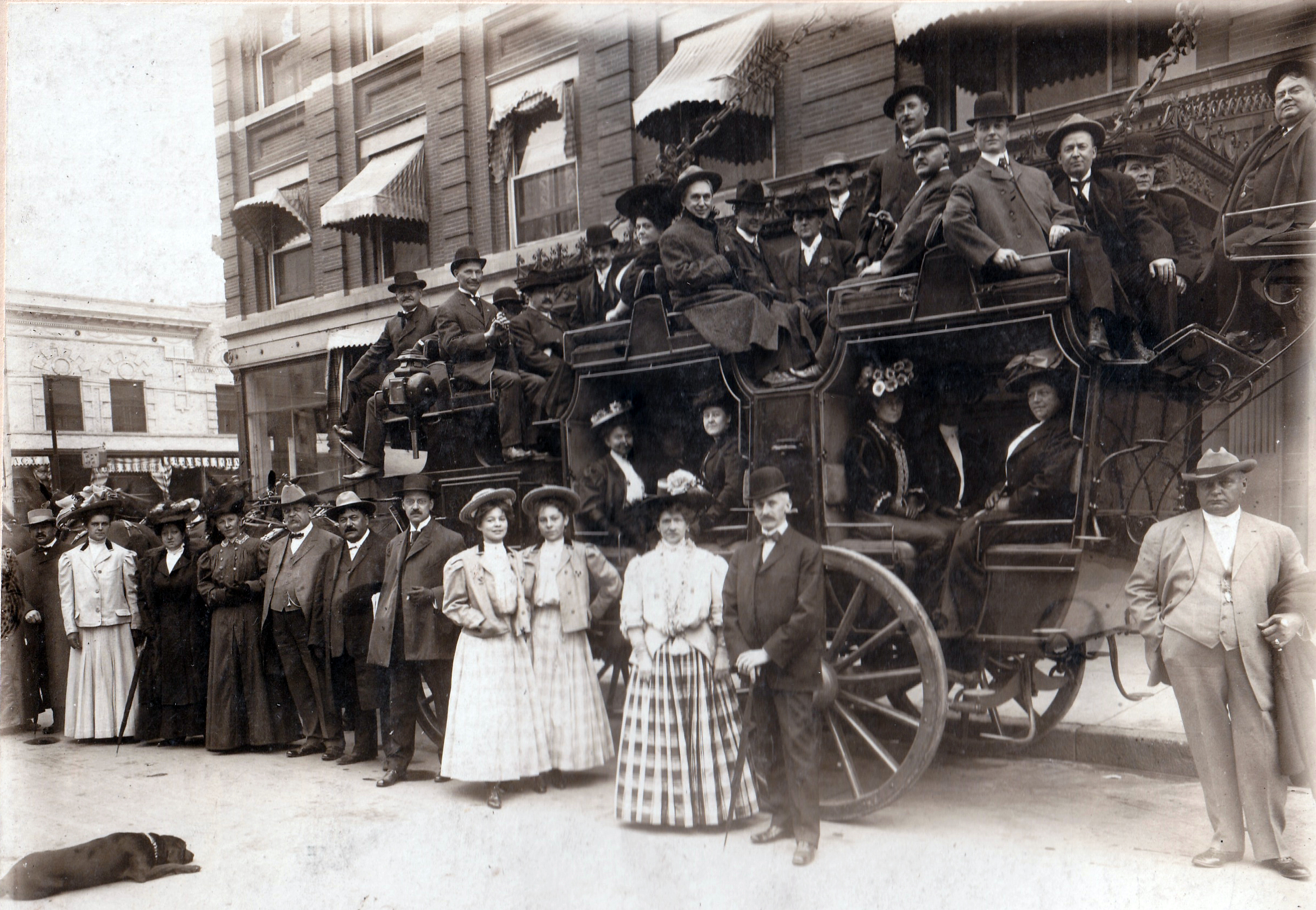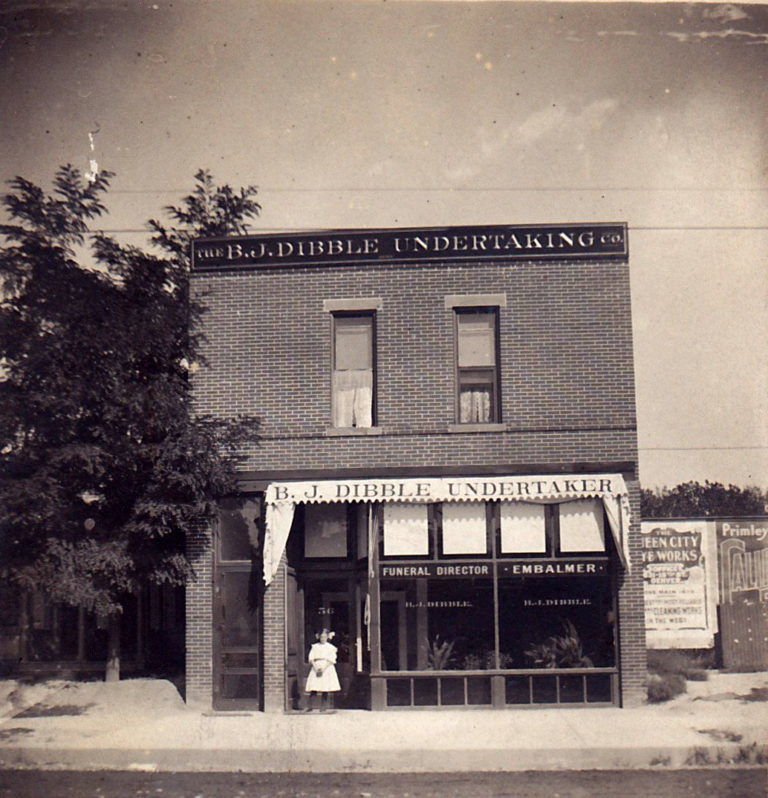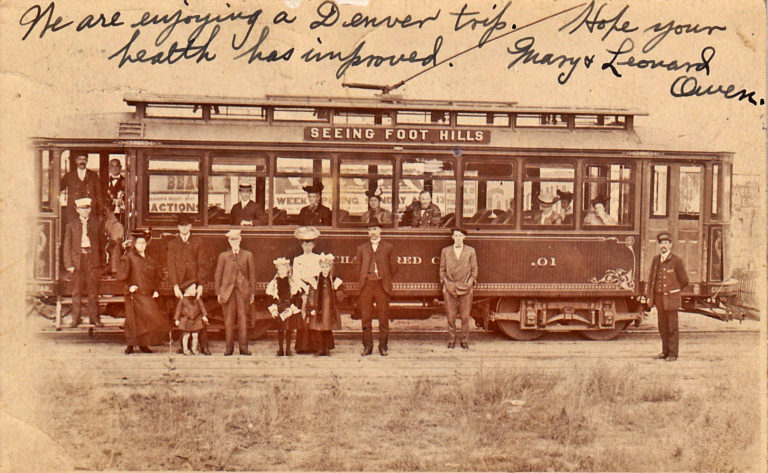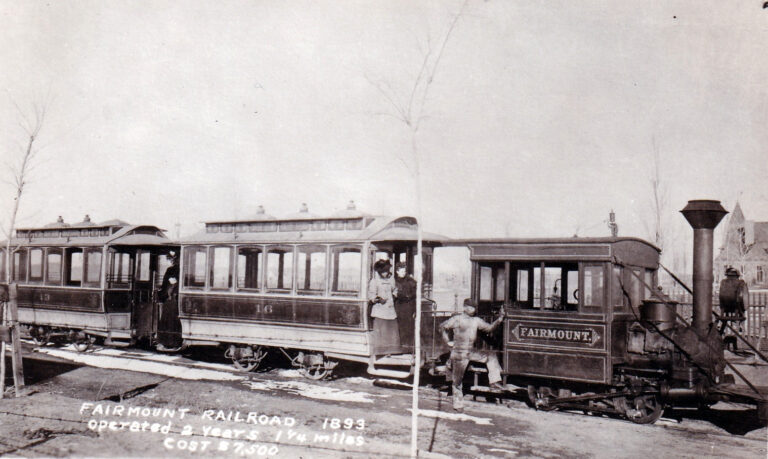Written on the back of this photo is: “September 29 – 1907 – Elks Clam Bake – Started from Adams Hotel – Denver, Colo.” This gathering is probably a hungry bunch, waiting to be transported to the clam bake from their gathering spot in front of the Adams Hotel. I could find no record of where exactly the clam bake was held that day.
I’ve never seen a horse-drawn vehicle like this one and had no luck in pinning down information about it. To my way of thinking, it was built for looks, not for function, and it looks heavy. Looking out beyond the heads of the people standing at the left, I can make out enough shapes, including silhouetted horses’ ears, for what are probably four horses.
It appears that the day was rainy – I count at least three people with umbrellas, and I see what appear to be puddles at the feet of those standing to the left. It’s interesting to note the two identically dressed women, possibly twin sisters, standing third and fourth from the right.
The 125-room Adams Hotel opened in 1902 and was built for $125,000 by George H. Adams, a millionaire cattleman who had come out to Colorado from Milwaukee around 1870. Its rooms configured into 60 suites, all having outside windows, it was a bustling place, a location for weddings and business meetings and for dining in its dining room, café or buffet and grill area. After George Adams died in 1904, his wife, Addie, would take over as proprietor for several years, living at the hotel. Patrons included the wealthy, as one of the hotel’s night clerks discovered first-hand in March of 1910, when George W. Clarke of New York entrusted the clerk to store his cash, i.e., $160,000 in $1,000 bills, in the hotel’s safe overnight, as he had arrived in town after the bank had closed. The Adams was razed in the late 1960’s.
The Benevolent and Protective Order of Elks (B.P.O.E.) is a fraternal organization that started initially as a social club in New York City in 1867. In 1868, it took on its current name, adopting some of the rituals utilized by the Masons. The B.P.O.E. currently claims to have approximately one million members.
Written on the back of this photo is: “Property of Mr. Paul A. Haberl, 1770 High St., Denver Colo.” My wife, Bev, did some searching in Ancestry.com and found a picture of Paul Haberl in the Haberl Family Tree. Comparing this photo with that picture, which is linked to Paul’s 1770 High Street home address in Denver, she verified that Paul Haberl is the sixth man from the right standing on the top level of the omnibus. (Sitting in front of him is a man with a cigar in his hand looking toward the camera.)
Paul A. Haberl, obviously a member of the Elks, was a business entrepreneur and inventor, whose mainline business was the Haberl Lapidary and Jewelry Company on 17th Street. (I understand that a lapidist cuts, polishes, or engraves precious stones, usually stones other than diamonds.) Paul, as well as his older brother, Anthony, came by their profession honestly, as their German-born father, Ignatius, was a jeweler and lapidist. Paul, born in New Jersey in December of 1863, accompanied his father, his mother, Philadelphia native Celina (Haag) Haberl, and brother Anthony in their move to Denver from New Jersey in the 1860’s. Paul’s younger brother, Frederick, would be born in 1869 in Denver, and his younger sister, Anna, born in New York in 1872, would be adopted by Ignatius and Celina in 1880.
By 1890, Paul and his father were both overseeing the work performed at the jewelry and lapidary manufactory on Blake Street owned by Paul’s older brother, Anthony, who sold the items manufactured there at his jewelry store at 1704 Lawrence Street. By then, acknowledgment of Paul’s acumen in the field of lapidary was exhibited when he landed the assignment to oversee the petrified forest exhibit at the New Orleans World Exposition.
Paul’s commercial interests did not lie in jewelry and lapidary alone – Denver city directories for the years 1896 to 1899 show that, in addition to his jewelry and lapidary business, he manufactured and sold artificial limbs. In this regard, see the information below about the patents he obtained, including one for an artificial foot.
In 1890, Paul married Josephine C. Kopper, daughter of Albert C. and Regina (Sohm) Kopper. Josephine was born in St. Louis, Missouri, in 1868, and she and her mother would subsequently move to Oregon. Regina, who had immigrated to the U.S. from Austria, would marry German-born Albert Kopper in 1882, and they would move that same year to Denver, most likely because of Josephine’s health. Perhaps Josephine suffered from tuberculosis, given the reputed benefits of Colorado’s altitude and dry air for the treatment of that disease. Paul and Josephine would have three children, Regina, Pauline and Richard.
In addition to his expertise in jewelry and stones, Paul was an inventor with a particular interest in fishing. His patented objects included: 1) an artificial foot (March 1897); 2) a fishing fly rod tip (August 1915) with co-inventor Edgar Warren; 3) a can opener with detachable blade (September 1925); and 4) a floating fishing lure (December 1931). By the 1920s, Paul had formed the Perfection Tip Company, the title of which most likely referred to the fishing rod tip he patented with Edgar Warren. He operated this business out of the family home at 1770 High Street, and by one account, Paul, his son, Richard, and Edgar Warren all became partners in the company. It appears the company may have grown significantly, for by the time of the 1930 census, Paul and Josephine’s son, Richard, now married with his own family, was identified as a manufacturer of fishing tackle. We do know that the Perfection Tip Company was still in operation in 1950, and at that point in time Richard owned a half-interest in the business. I Googled “Perfection Tip Company Denver” and found that company name at the following link to johnnyspond.com: http://www.johnnyspond.com/perfection-tip-guides-and-tops.html . Whether it’s descended from Paul’s company I don’t know.
The Denver business experience of Paul’s father-in-law, Albert Kopper, during the late 19th and early 20th centuries would epitomize that of many German immigrants in Denver at that time. Born in Germany in 1849, Albert emigrated to the United States in 1874, and in 1882, as described earlier, he came to Denver from Oregon with his new wife, Regina, and her daughter, Josephine. In 1884, Albert would open a saloon on Lawrence Street. In December of the following year, having purchased two lots for $10,000 at the corner of 20th and Lawrence containing a house and a small commercial building, he would move his saloon into the commercial building. His newspaper ads at the time reached out to working men, stating, “All working men patronize me. You will be well treated.” In April of 1885, Albert became a U.S. citizen.
At this time in Denver’s history, fully one-third of Denver’s saloonkeepers were German-born. This can be attributed to the fact that Germany had raised beer brewing to an art form, aided in part by passage of the Beer Purity Law in Bavaria in 1516, later applicable throughout Germany, which specified that all beer must only be made from barley, hops and clean water. In the 19th century, Germany witnessed a revolution in the types of beers it was producing, and
until the 1980’s had the largest number of breweries in the world.
Albert appears to have prospered during the 1880s, for in 1889 he took out a $15,000 loan, tore down his saloon and built the three-story Kopper’s Hotel and Saloon Building, which is still standing, in the 1200 block of 20th Street. The main floor housed his saloon and a beer bottling plant and would later include a restaurant. Initially, Albert probably left the top two floors, or hotel portion, of the building unfinished, for in 1892 he borrowed $18,000 to do interior renovations and finish the top two floors. His was the classic working-class saloon and hotel, with the saloon and restaurant on the ground floor and the hotel available to both travelers and long-term guests. Unfortunately, the next year would see the beginning of a four-year economic depression in the U.S., otherwise known as the Panic of 1893 – bad timing for Albert, who was carrying a heavy debt load. But he made it through that decade, probably on the back of his saloon earnings.
In 1916, Albert and his fellow saloonkeepers would face the demise of their businesses when the Colorado legislature passed a state-wide ban on the sale of alcoholic beverages. Over four hundred Denver saloons and breweries would close as a result, and anti-German sentiment engendered after the start of World War I did not help that community’s prospects for economic recovery. Albert would sell the property in 1918, and by 1919 it was in the hands of a man named Elmer Sommers, who rechristened the place the Airedale Hotel, reportedly after his favorite breed of dog. Albert would go on to establish a cigar shop in Denver’s Mack Building at 16th and California.
It would be fun to go back in time, meet up with Albert Kopper and see the look on his face when informed that in the year 1999 his hotel and saloon building would be placed on the National Register of Historic Places. It would meet National Register Criterion A because “The building is specifically one of a handful of surviving representatives of the city’s early ethnic saloons and the overnight working-class accommodations industry, and its history serves as a good example of both the social history of the German-American community and the impact that this immigrant group had upon the early development of the city of Denver.” Here is a link to Kopper’s Hotel and Saloon Building: https://en.wikipedia.org/wiki/Kopper%27s_Hotel_and_Saloon#/media/File:Kopper.JPG .
Note the pediment identifying its rechristening as the Airedale in 1919.
Paul and Josephine and Josephine’s parents Albert and Regina would live out their lives in Denver, Paul until July of 1936 and Josephine until 1950. Albert and Regina would pass away in 1924 and 1922, respectively. Paul and Josephine’s remains are interred at Crown Hill Cemetery in Wheat Ridge, and Albert and Regina’s remains are interred at Denver’s Riverside Cemetery.
REFERENCES:
- Albert Kopper saloon ads in multiple newspaper issues, Colorado Historic Newspapers Collection at https://www.coloradohistoricnewspapers.org/
- “Benevolent and Protective Order of Elks,” wikipedia at https://en.wikipedia.org/wiki/Benevolent_and_Protective_Order_of_Elks
- “A Brief History of German Beer,” germanfoods.org at https://germanfoods.org/german-food-facts/brief-history-of-german-beer/
- “The City of Denver and State of Colorado,” 1890, Google Books at https://www.google.com/books/edition/The_City_of_Denver_and_State_of_Colorado/sXMUAAAAYAAJ?hl=en&gbpv=1&dq=haberl+colorado+1890&pg=PA118&printsec=frontcover
- “Info on Winchester rod and appraisal,” by cwfly, 3/24/17, The Classic fly Rod Forum at http://classicflyrodforum.com/forum/viewtopic.php?p=746343#p746343
- Definition of Lapidary, Merriam-Webster at https://www.merriam-webster.com/dictionary/lapidary
- Denver, Colorado, City Directory for 1927 at www.ancestry.com
- “Denver History Tours Blog” at http://denverhistorytours.blogspot.com/2008/06/adams-hotel.html
- ‘”Deposits $160,000 at Hotel Adams,” The Larimer County Independent (Fort Collins) dated March 10, 1910, www.newspapers.com at https://www.newspapers.com/image/588374752/?terms=%22hotel%20adams%22&match=1
- “George H Adams Builds Hotel,” dated May 3, 1901, Colorado Historic Newspapers Collection at https://www.coloradohistoricnewspapers.org/?a=d&d=WHN19010503-01.2.41&srpos=5&e=–1900—1904–en-20–1–img-txIN%7ctxCO%7ctxTA-George+h+adams+denver——-0——
- “George H Adams Dies in Denver,” The Kansas Weekly Capital dated June 17, 1904, www.newspapers.com at https://www.newspapers.com/image/519081653/?article=265f5c82-2fa6-482a-971a-c49f11e97175&focus=0.46143484,0.7196579,0.596593,0.7989187&xid=3355
- Google Patents at https://patents.google.com/patent/US1553442A/en and https://patents.google.com/patent/US1834277
- Haberl Family Tree at www.ancestry.com
- “The History of the Benevolent and Protective Order of Elks” at http://www.bpoe858.org/BPOE%20History/BPOE%20History.htm
- “The Hotel Adams,” The Fort Collins Express and the Fort Collins Review at www.newspapers.com at https://www.newspapers.com/image/588383540/?terms=hotel%20adams&match=1
- Kopper’s Hotel and Saloon, National Register of Historic Places Registration Form, National Park Service, U.S. Department of the Interior at https://npgallery.nps.gov/GetAsset/5fda589c-b203-4445-af78-2bc6b9ebe3c0
- “Official Gazette of the United States Patent Office,” 1915 at https://www.google.com/books/edition/Official_Gazette_of_the_United_States_Pa/jk5RAQAAMAAJ?hl=en&gbpv=1&dq=haberl+and+warren+fly+rod+tip+patent&pg=PA226&printsec=frontcover
- “Panic of 1893,” wikipedia.org at https://en.wikipedia.org/wiki/Panic_of_1893
- Sumner Family Tree at www.ancestry.com
- Untitled document, Denver Public Library Digital Collections. ( To view this document, go to https://digital.denverlibrary.org/digital/search and enter “Perfection Tip Company Haberl” in the “Search” box.)
- U.S., Passport Applications, 1795-1925 for Albert Kopper at www.ancestry.com
- 1920 Corbett & Ballenger’s 48th Annual Denver City Directory, Denver Public Library Digital Collections at https://digital.denverlibrary.org/digital/collection/p16079coll28/id/25200
- 1896, 1897, 1899, 1905, 1915 and 1923 Denver City Directories at www.ancestry.com
- 1870, 1900, 1920 and 1930 Censuses (www.ancestry.com)
- 1897 Haberl Patent for Artificial Foot at https://patents.google.com/patent/US577133




